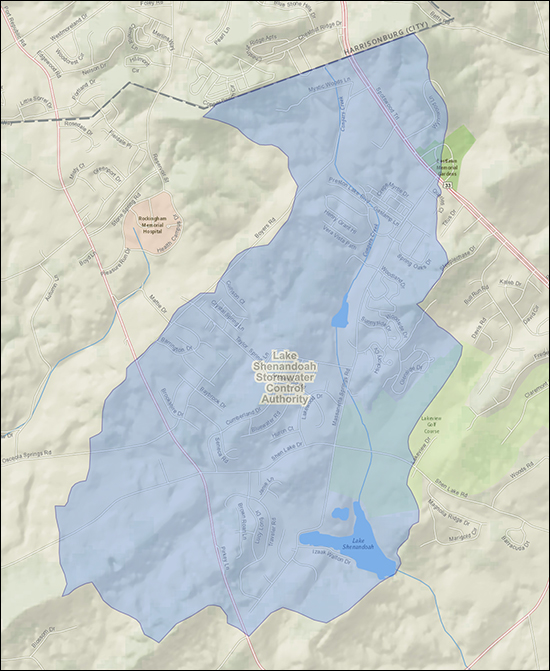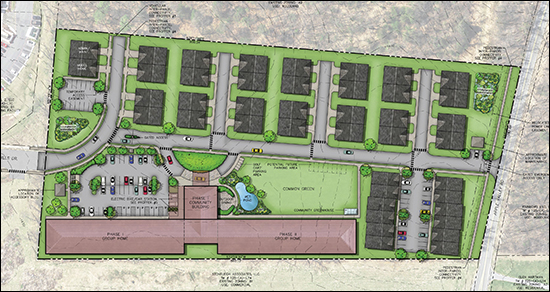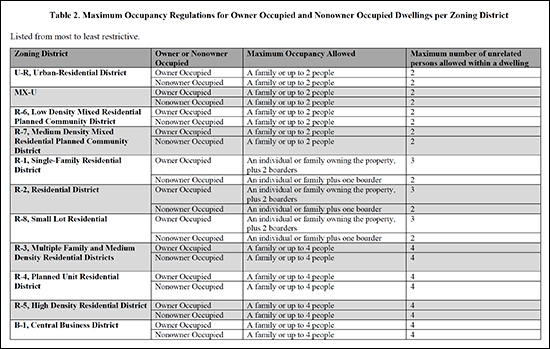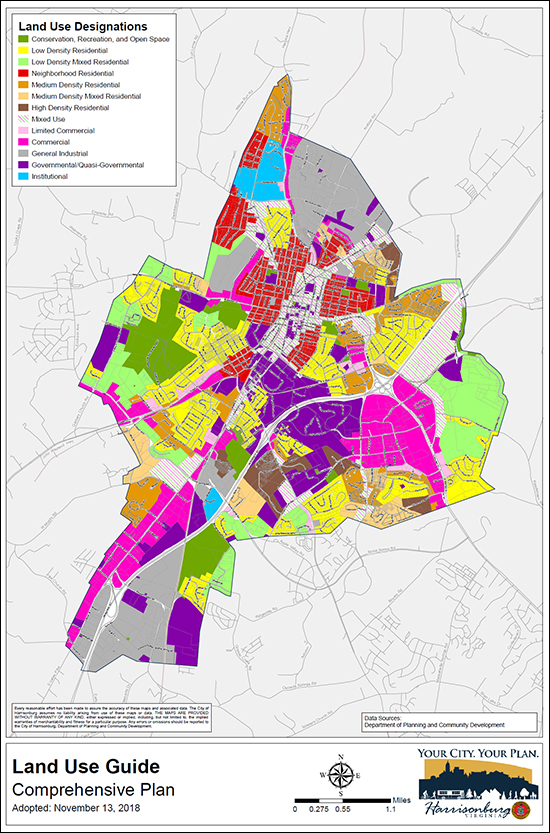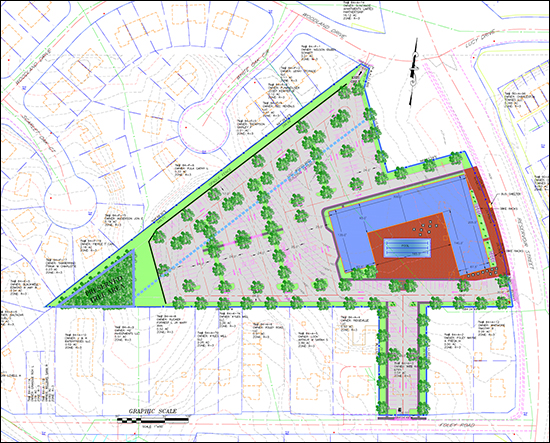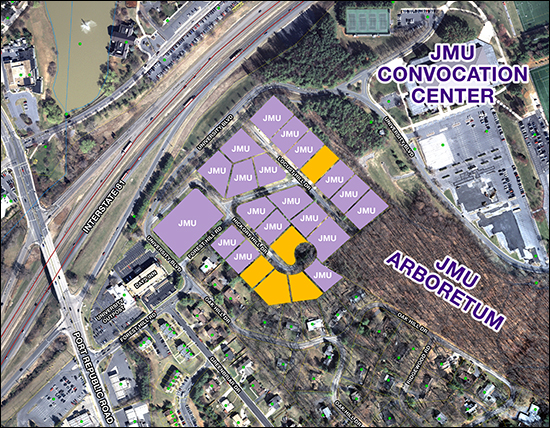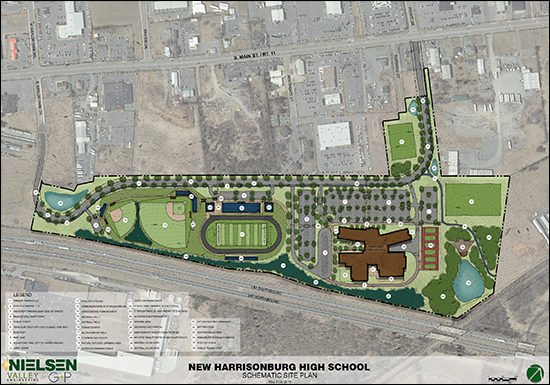Government
| Newer Posts | Older Posts |
Large Mixed Use Development With 728 Homes (Plus Commercial Space) Planned On 133 Acres Just Outside Harrisonburg |
|
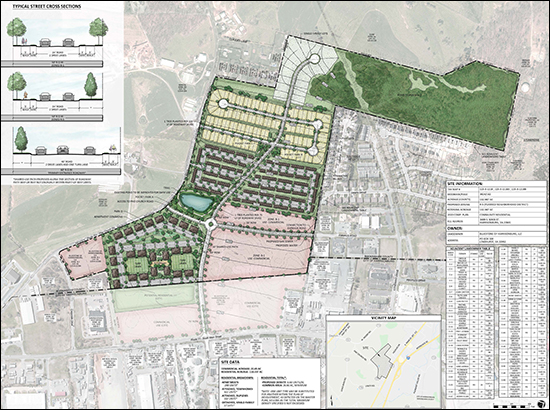 Download the master plan as a PDF here. A 133 acre mixed use development is in the planning / approval process in Rockingham County - just south of the City of Harrisonburg. This development would feature:
This planned development is located just south of the DMV, and backs up to Pikes Church Road. The land needs to be rezoned, slightly (from R-3C to R-5C) for the development as planned to move forward. County staff recommended approval last week and the Rockingham County Planning Commission unanimously recommended approval this week. The next step is for the rezoning request to go before the Board of Supervisors. The developer had previously rezoned the land, in 2009, for a 384 unit residential development. This updated rezoning, 11 years later, would increase the density to 728 units. The developer plans to have common areas for recreational spaces such as turf fields, a playground and walking trails. Download the full packet from the rezoning request here. As a random side note, the developer is seemingly planning to call the development "Bluestone Development" - which might cause a bit of market confusion given the existence of a large neighborhood in Harrisonburg called "Bluestone Hills". Maybe not. I guess if someone says they live in Bluestone, you'll have to ask if that's the City Bluestone or the County Bluestone. | |
Perhaps Unsurprisingly, Most Harrisonburg Short Term Rentals Are Near EMU, Downtown or JMU |
|
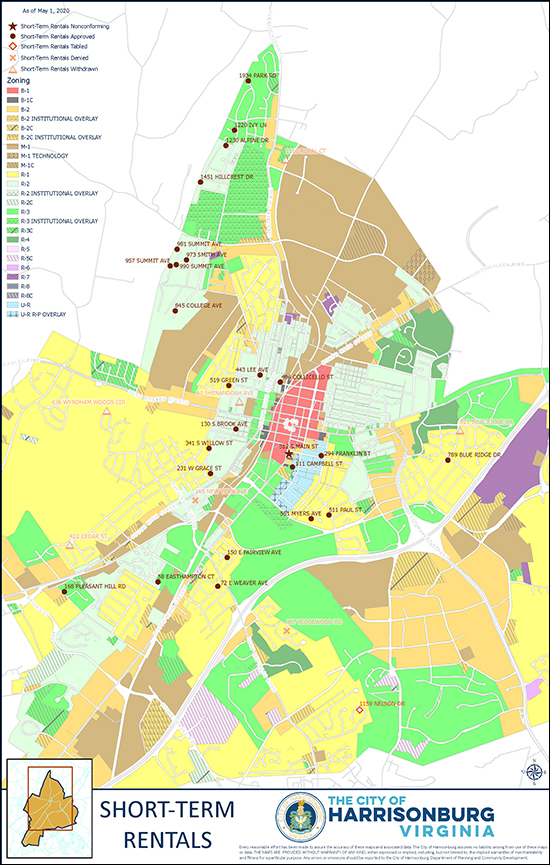 Perhaps it will come as no surprise that most of the short term rentals in the City of Harrisonburg are located close to EMU, Downtown Harrisonburg or JMU. The map above shows short term rentals approved by the City of Harrisonburg as of May 1, 2020. While the City is in the process of adjusting some of their processes and guidelines for how to potentially use your property as a short term rental, the main thing to remember is that you need to get approval for doing so. Learn more about the process of establishing a short term rental in the City of Harrisonburg here. | |
Rockingham County Considers Purchase of 27 Acres Between Barrington, Lakewood for Stormwater Management Purposes |
|
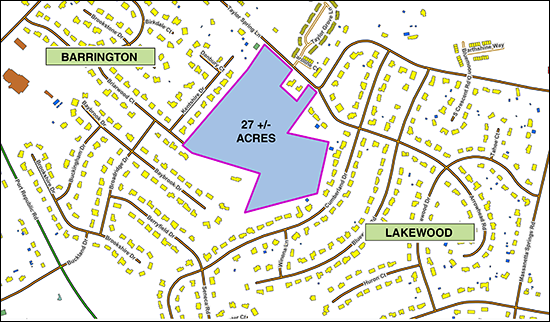 Rockingham County will likely purchase the 27-ish acre parcel on Taylor Spring Lane between Barrington and Lakewood to use for managing stormwater in the Lake Shenandoah Watershed. The purchase has not been finalized, but the County is in discussions with the land owner regarding the purchase. The County does not have a design for how the property will be used, but according to Lisa Perry, (Environmental and Land Use Manager for Rockingham County) it is safe to say that the low lying areas of the parcel will be used for stormwater storage capacity. My understanding is that only half of the property will be needed for stormwater management and that the County intends to use the other half of the land for a future County park once funding is available to build the park. Here's a reminder of some of the details of the Lake Shenandoah Stormwater Authority... If you live in (or own property in) the area shown above, you'll have a new tax to pay come December 2020 - a fee that will go towards funding upgrades in the stormwater infrastructure in the Lake Shenandoah Watershed.
These fees should bring in approximately $2.8 million over the next ten years - though the total estimated costs for the needed infrastructure improvements are between $3.15 million and $4.75 million. Also in their June meeting, the Lake Shenandoah Storm water Control Authority Board (made up of the same members as the Rockingham County Board of Supervisors)
If you live in this area, hopefully the news of this new tax isn't a surprise to you -- as it has been discussed for about a year now. The County held the first public hearing on this matter back in July 2019. | |
How Should The City Improve Parking in Downtown Harrisonburg? |
|
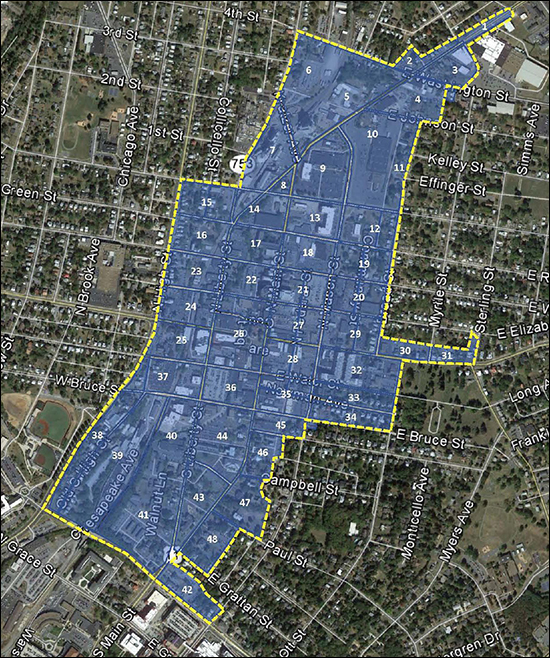 The City wants to know what YOU think about parking in the downtown area. They have developed a series of recommendations from a forum and more than 1000 survey responses. These recommendations include ideas such as:
The City wants to know how much YOU agree with the recommendations they are considering. Take the survey NOW (or before Feb 7, 2020) at the link below... | |
Will City, County Buy the Denton Building in Downtown Harrisonburg To Expand Courts, Judicial Offices? |
|
 Will the City of Harrisonburg and/or Rockingham County be purchasing the Denton Building in downtown Harrisonburg? Maybe? Possibly? Feel free to email me (scott@HarrisonburgHousingToday.com) with any additional information you might have. I've heard about this from a few folks who are plugged in downtown, and there has been some reporting of this possibility in the Daily News Record... "The city and county are looking for more space for courts and judicial offices and have identified the Denton building on Court Square as a possible location." "The Denton building lies on two parcels with three addresses — 50 S. Liberty St., 58 S. Liberty St. and 61 Court Square — with a combined value of nearly $3.9 million, according to the 2019 assessment." "In January, the city and county bought the parking lot and two-story building to the south of the Denton building for $425,000 from CFSMCS LLC, according to Rockingham County real estate records." | |
Rockingham County Considers Adopting Stone Spring Urban Development Area Plan Into Comprehensive Plan |
|
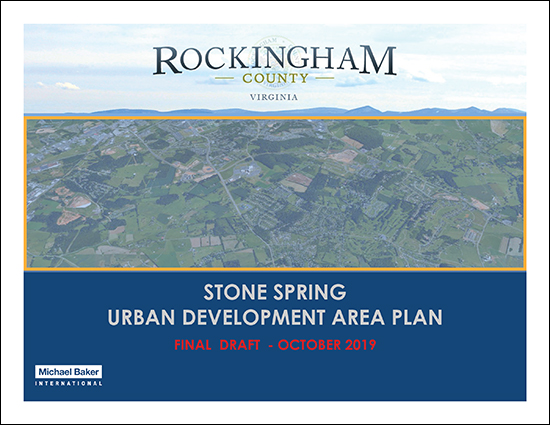 The Rockingham County Planning Commission will meet tomorrow (Nov 19, 2019) at 6:00 PM in the Rockingham County Administration Center to discuss incorporating the Stone Spring Urban Development Area Plan (pdf) into the Comprehensive Plan. From the plan... The Stone Spring Urban Development Area Plan (Stone Spring UDA) creates a 20-year vision for the development of new walkable neighborhoods and infrastructure investments within four focus areas for growth. This map (from the plan) shows the four focus areas: Stone Port, Stone Ridge, Boyers Crossing and Crossroads... 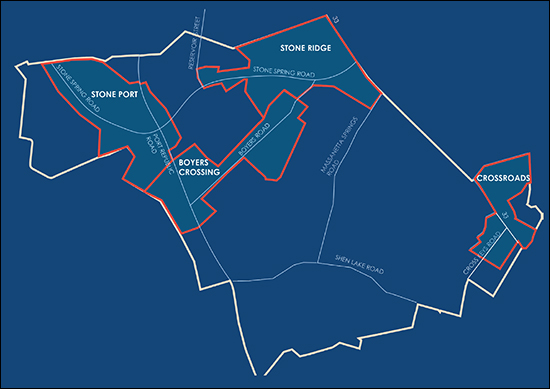 Further... The Stone Spring UDA provides a blueprint for neighborhood development based on traditional town patterns, known as Traditional Neighborhood Development (TND). TND is based on the principle that neighborhoods should be walkable, achieved by compact, mixed-use development, with pedestrian-oriented development blocks that are sized for easy walking distance and characterized by an interconnected network of streets that are articulated with trees, on-street parking, and a variety of routes for vehicle traffic while facilitating walking, cycling and transit. The Stone Spring UDA Plan focuses on the physical form and massing of buildings—on scale, block size, and the relationship between building edges and the public realm. Here's an example of a potential neighborhood layout in the Boyers Crossing focus area... 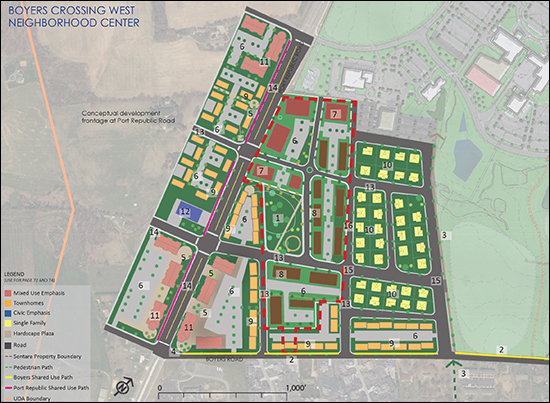 And a conceptual layout for Stone Ridge... 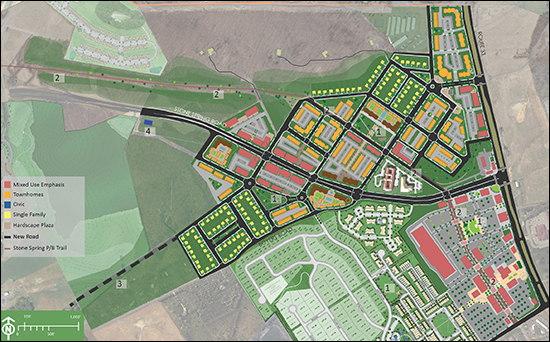 A few screen captures don't do justice to this 106 page plan -- so download the final draft of the plan here and take a look through it. And if you live in or near the Stone Spring UDA - buckle up for even more growth in the area... | |
Planning Commission Recommends Approval of 172 Unit Senior Housing Community (Crownpoint Independent Living) on Apple Valley Road |
|
A developer out of Williamsburg has requested that an 8.38 acre parcel on Apple Valley Road be rezoned to allow for the development of a senior living facility. The community would include 130 group home units (with 1-2 bedrooms) and 42 attached dwellings (duplexes or rowhouses) potentially as shown in the layout above. The group home units will be built as (2) three-story residential structures with a community building between them. Potential community amenities will include outdoor common areas, recreational activities, a dog area, a greenhouse, an electric vehicle charging station and more. The community will likely offer services such as housekeeping, a coffee shop, a hair/nail salon, fitness classes, etc. The living units in this development will be rented, not purchased, per the developer (Andy Piplico) and there will not be age restrictions but the average age of residents will likely be 84 years old. The Planning Commission voted 5-0 to recommend that this development be approved, and the Board of Supervisors will make that final decision in the near future. Read more about this proposed development: | |
How Many Unrelated People Can Live In A Home In Harrisonburg |
|
 It is a common misunderstanding that the zoning classifications can be interpreted as follows...
In fact, it doesn't work that way at all. So, how can we understand the limits of how many unrelated people can live in a property based on the zoning of that property? Below is a table of very helpful data -- tucked within the resource materials for the work session scheduled for tomorrow related to Short Term Rentals in the City of Harrisonburg. The same data can also be found, organized slightly differently, on the City's website here. download a PDF that you can actually read, here This table outlines how many unrelated people can live in a home (detached home, duplex, townhouse, condo, etc.) in Harrisonburg based on the zoning of that property. Of note, there can be exceptions to these generalities -- based on a special use permit for a property, or if a property use is "grandfathered in" based on that use existing since before zoning regulations limited the use. But this is a very helpful starting point for understanding how many unrelated people can live in a property in the City based on the zoning of that property. | |
All The Areas That Will Pay A Bit Extra In Taxes To Help Manage Stormwater in The Lake Shenandoah Watershed |
|
download a high resolution PDF here In late August, the Rockingham County Board of Supervisors approved the creation of the Lake Shenandoah Stormwater Authority. The authority will work to manage stormwater and mitigate damage from that stormwater throughout the Lake Shenandoah Watershed. Read more via the DNR on 8/29/2019) here. The Authority will potentially spend around $3.2 million to improve the stormwater system by creating new detention facilities and increasing the capacity of ditches and pipes. Property owners in the area shown above will pay some additional taxes that will fund the work of this Stormwater Authority, though the Authority will also pursue grant funding for the needed infrastructure improvements. As shown on the map above, the Stormwater Control Authority will include all or part of the following areas:
| |
83% of Harrisonburg Short Term Rental Special Use Permit Applications Approved |
|
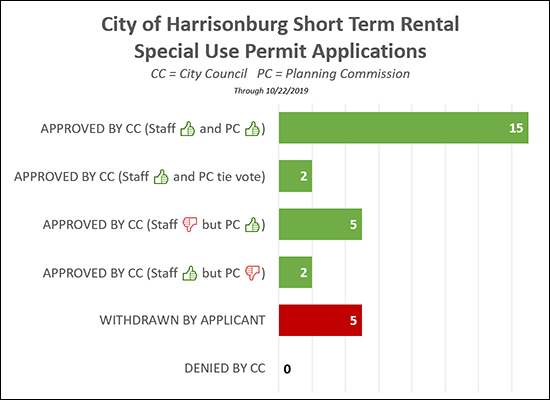 The Planning Commission for the City of Harrisonburg will hold a work session on October 29, 2019 at 2:00 PM to discuss Short Term Rental regulations. You'll find the agenda here and one of the attachments (this one) provides a concise overview of the status of each property for which a property owner has applied for a special use permit to use their property as a Short Term Rental. There are a few properties still working their way through the process, but of the 33 properties listed on the summary sheet, 29 have had an outcome of some sort and I illustrated those outcomes on the graph above. A few observations...
It will be interesting to see if there are any adjustments to the regulations or process for applying and reviewing those applications. Stay tuned -- or attend the work session! | |
How Should Vacant Land Be Developed In The City of Harrisonburg |
|
There are still vacant parcels of land in the City of Harrisonburg that might be developed in the future. Should all of these vacant parcels become student housing? Should they all be for detached homes? Should they all be for retail or professional office space? Clearly, no. As a part of the comprehensive planning process, the City of Harrisonburg develops a Land Use Guide that outlines how land in the City should be used. The Comprehensive Plan is developed over multiple years with many stakeholders, and is intended to be a vision for what the City would like to be in the future. As such, the Plan (and the Land Use Guide) are not regulatory documents that mandate particular uses of land -- but they are a guide that City staff and elected officials use as a reference point when making decisions. Read the Comprehensive Plan here. Download the Nov 13, 2018 version of the Land Use Guide here. Case in point -- the six-story mixed-use building approved last night on 6.6 acres on Reservoir Street. Let's dive into this as an example. As you'll see, the existing land use of the parcel is described as "vacant"... 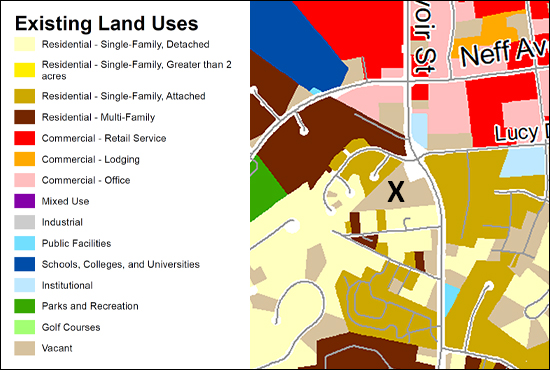 And when we look at the current zoning, we find that it is zoned R-3, as with most of the surrounding property. This zoning classification allows for single family homes, duplexes or townhouses. 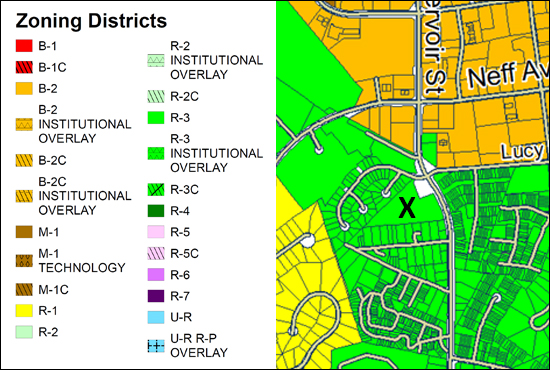 But things get interesting when we look at the Land Use Guide... 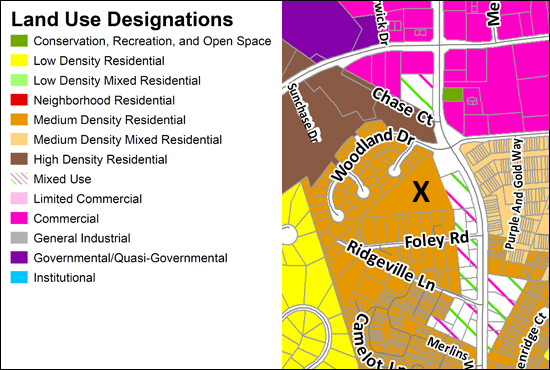 Here (above) you'll see that the Land Use Guide recommends that the front of the property be used for Mixed Use and the back of the property be used for Medium Density Residential. You'll see quite a few parcels along Reservoir Street with a Mixed Use designation, likely because Reservoir Street has become more and more of a thoroughfare for the City, with lots of townhouses (Avalon Woods, Breckenridge Court) and student housing (Charleston Townes) in that vicinity. Thus, the City (staff, elected officials, citizens who participated in the comprehensive planning process) thought that it would be reasonable (and best) for those parcels fronting on Reservoir Street to be used for mixed use development. In this particular example, though, things get tricky when considering the intended use and the proposed use from multiple perspectives. The property owner and intended developer of the property proposed that the entire property be used for a mixed use development with retail, office and apartments. This makes sense to them, I suppose, because the front of the property is supposed to be used for mixed use development. Many of the neighboring property owners would seemingly not like to see a mixed use development take place on this site. I suppose I can't ascribe anything particular to how those neighboring property owners would like to see the property developed -- because the main focus of their recent comments have been about how they do not want it to be developed. They don't think that a mixed use development should be approved for this entire parcel. This makes sense to them, I suppose, because the back portion (majority) of the property is intended to be used for a medium density residential development, and not a mixed use development. So, as you can see, the Land Use Guide can be a helpful tool for property owners and developers to use when they are considering ideas for developing land in the City -- though sometimes what "should be done" per the Comprehensive Plan and Land Use Guide is not entirely clear depending on the particular property. Last night, City Council approved the requests from the property owner to rezone the property and allow for the mixed use development to move forward. Read more about the nuances of that decision and discussion here... Daily News Record: City OKs Mixed-Use High-Rise The Harrisonburg Citizen: Council narrowly approves mixed-use development in Reservoir St. neighborhood | |
Six Story Mixed Use Building Proposed on 6.6 Acres on Reservoir Street |
|
view as PDF Two parcels totaling 6.6 acres might soon be home to six-story mixed use building to include:
Here's a map more clearly showing the surrounding properties... City staff recommends approving the development, noting that...
At the Planning Commission meeting, owners of some of the neighboring properties expressed concerns...
The Planning Commission recommended denial of three of the four requests from the developer. They recommended that City Council not rezone the property, not allow more than 12 units in a building on the property and not allow the building to be more than four stories or 52 feet -- though they did recommend that City allow non-residential uses in a building with R-5 zoning, though that would require the property to be zoned R-5. So -- City staff supports the proposed development and the Planning Commission does not. Next up -- City Council! When City Council met earlier this month they ended up holding off on a vote as to whether to allow for this development, since one of the members of City Council (George Hirschmann) was not present. They will meet today to review the requests again and to potentially vote on whether to approve them. | |
Maybe JMU Bought Those Houses To Straighten Out A Road? |
|
(click the map for a larger file) I'm not sure if it was the plan all along, but it seems JMU's acquisition (over quite a few years) of homes in the Forest Hills area has allowed it to now (potentially) partner with the City and Commonwealth to straight out the end of University Boulevard that has a big (slow) loop as it approaches the Days Inn. Here are the properties that JMU owns per my most recent accounting... (click the map for a larger file) The most recent development, as covered by The Citizen (Council takes next step toward major re-routing of University Boulevard) is that the City Council approved the Department of Public Works' plan to seek money from the Commonwealth of Virginia to accomplish this project. Here's how it would go down...
If this funding request is approved, construction on this realignment of University Boulevard would not be complete until December 2023. So, stay tuned, but don't expect any changes to the road in the immediate future. | |
There Might Not Be Anyone To Blame For Urban Flooding in the Lake Shenandoah Watershed Area |
|
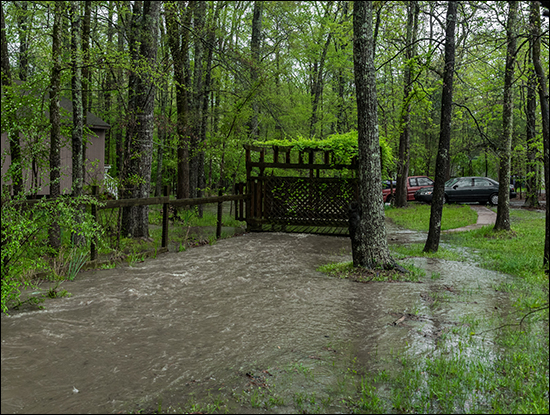 If your house, or street, or neighborhood floods during heavy rainfall events in the Lake Shenandoah watershed area, it likely seems that someone must be at fault - someone must have messed up - someone must be blamed for the drainage problems. But who is to blame? Many neighborhoods were developed just southeast of Harrisonburg over the past 20 years - and in each case, the developer would be told by the County how to develop the land from a stormwater perspective based on requirements from the State. So - if the State (Commonwealth of Virginia) creates guidelines, the County enforces them, and the developer implements them, who is to blame if your house, street or neighborhood is flooding? It is tempting to say that the developer must be at fault - but they were just doing what the County was telling them to do to manage stormwater. We could then blame County officials - but they were just doing what the state was telling them to do to manage stormwater. So, hmmm.... Here's a bit of further commentary from Mr. Miller (the County's attorney) at the public hearing held by the Board of Supervisors...
So, if everything was being done based on what the experts at the state were mandating - then it seems that local builders, developers and County officials aren't really the ones to be blaming for urban flooding. Yes, if all of these neighborhoods were developed today, the developer would be told by the County to do more to mitigate stormwater based on requirements from the state - but those guidelines and requirements were not in place when these neighborhoods were developed. A few other related notes...
If this topic interests you, consider attending the Work Session on the topic to be held this Wednesday (August 21, 2019) at 6:00 PM at the Rockingham County Administration Center. No action will be taken at the meeting, but it is an opportunity for further discussion and input. Also, as a refresher, these recent conversations are a result of the County's proposal to create a Stormwater Authority specifically for the Lake Shenandoah Watershed. The Authority could potentially spend around $3.2 million to improve the stormwater system by creating new detention facilities and increasing the capacity of ditches and pipes. If the cost of these potential improvements was divided evenly between the affected parcels, it would cost approximately $200 per year per parcel. Though... "Mr. Miller stated these are only estimates, because there are too many unknowns until engineering studies are conducted. Assistant County Administrator Armstrong noted that the $3.2 million cost is with no contribution from state or federal grants that the County may be able to obtain to offset costs." | |
What If You Could Build A Duplex On Every Single Family Home Lot? |
|
 What if, on any single family home lot, you could build a duplex -- or even a townhouse! Would that help more affordable housing to be built? Would that upset existing single family home owners? Oregon is giving it a try! :-) From NPR... Some excerpts of interest follow...
Read the entire article for further commentary and perspectives... | |
Resolution to Create Stormwater Authority Tabled |
|
A public hearing was held on July 17, 2019 and it drew quite a crows (70+ people) and lead to several hours of discussion. At the end of the meeting, the Board of Supervisors decided that they needed to spend more time looking into the comments and concerns raised by local residents. The Board tabled the resolution that would have created the authority, and it is not clear when any next steps will be taken. It seems that much of the concern and discussion was related to how to pay for the needed upgrades to the stormwater system. I don't think anyone questions that those upgrades are needed. Here is an excerpt from a July 18, 2019 article in the Daily News Record, Stormwater Authority Tabled...
For further context, the County's website (linked above) explains that...
| |
Concept Plan of New Harrisonburg High School |
|
Click on the links below to check out a concept plan dated May 31, 2019 for the new Harrisonburg High School, which seems to feature:
Follow updates on this new high school here. | |
Comparing Monthly Property Tax Bills Between Harrisonburg and Rockingham County |
|
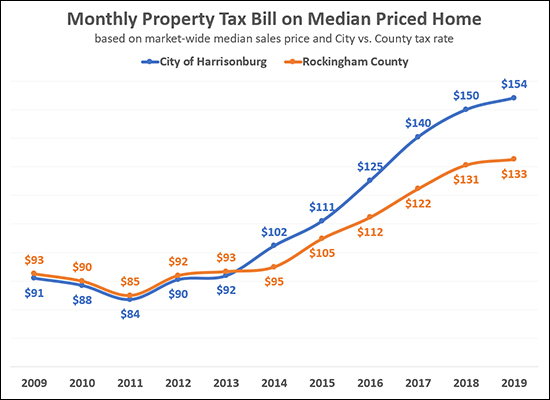 Getting a bit further into this topic -- yesterday I was looking only at the changes in the property tax rates in the City and County -- as shown here. Today (thanks for the idea, Mike) I looked at how a monthly property tax bill has changed over the past decade for a median priced home in the City and County. To be clear, this analysis uses:
As shown above, it has become more expensive (16%) to pay property taxes on a home in the City of Harrisonburg as compared to a similarly priced (assessed) home in Rockingham County. Now -- does this cause anyone to move from the City to the County? Or does it cause anyone new to the area to buy in the County instead of the City? Not necessarily - or at least that has not been my experience in working with buyers and sellers in the past ten (+) years. | |
Real Estate Tax Rates Finalized in Harrisonburg, Rockingham County |
|
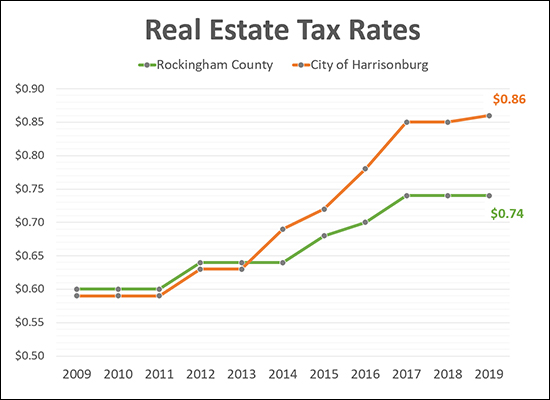 The real estate tax rates have been finalized for the 2019-20 fiscal year...
For some context...
For an even broader context...
And to translate it into monthly costs...
| |
Thoughts and Questions on Short Term Rentals in the City of Harrisonburg |
|
 More great reporting over at The Citizen about short term rentals...
And a few prior articles...
And to follow that recap, some thoughts and questions... Does approving a Short Term Rental remove a property from the local housing stock? Not really - or not most of the time? Most of the Short Term Rental applications have been from owners who live in their home and want to offer a portion of their home as a short term rental option. So - those properties aren't being removed from the local housing stock - the owners still live there. Further, the approval of a non owner occupied property as a Short Term Rental wouldn't remove a property from the "purchasable housing stock" since the owner is presumably currently renting it to a long term tenant. Technically, a property owner could decide to stop renting a house to long term tenants and start renting it only to short term tenants -- thus making it such that most occupants of the house would not be local residents, but just those passing through. In that situation it would, in some ways, be moving the property from the local housing stock to the "local hotel stock" - if that were a thing. This (converting a home from being occupied by the owner or a long term tenant to being occupied only by short term tenants) doesn't seem to be the majority of what is being proposed or considered - and my general sense (not scientific or data driven, I know) is that there is only so much of a market of would-be tenants for short term rental properties. If one hundred local property owners moved out of their homes, were approved to use them as short term rentals, and listed them on AirBNB, I don't think that all, or most or would be pleased with the rental demand from short term tenants. If one Short Term Rental is approved on a street or in a neighborhood will lots of other property owners follow suit and apply to become short rentals? Not really - or not most of the time? I think most folks who own and live in their homes in Harrisonburg enjoy living in their homes, probably by themselves. I don't think that the ability of one home out of 50 (in a hypothetical neighborhood) is going to cause more and more property owners to either take in short tenants to live with them, or to move out of their homes and start renting them to short term tenants. Will investors start buying up properties in Harrisonburg as short term rentals? Probably not, or not in large numbers? I don't think there is an untapped demand by short term tenants that would reward those investors with frequently rented short term rental properties. Yes, it is technically true that renting a property to 100 tenants for short terms instead of one tenant for the entire year is almost certainly going to be more profitable - but I just don't think there is that much demand by short term tenants. As a side note - there are plenty of localities where ordinances limiting short term rentals do not exist. I tend to think that investors would be more likely to invest in a property where short term rentals are not regulated before they'd invest in a community where there are somewhat restrictive regulations in place. Will the City's new Short Term Rental policy increase or decrease the number of City properties that are being used as short term rentals? To me, this is one of the more interesting questions. Property owners in the City have been operating short term rentals in the City for quite some time now (5+ years?) without actually having the legal ability to do so. Most of the concerns above seem to be regarding the hypothetical possibility that more and more and more properties will be come short term rentals. I tend to think that we won't see a large shift in the number of properties being used as short term rentals when comparing (for example) 2018 and 2020. Of the folks using their homes as short term rentals prior to these regulations:
Those four (non-exact, non-numerical) changes above would seem likely to result in a net decline in the number of short term rentals -- and moving forward, property owners would seem to be less likely to want to use their property as a short-term rental as there is now a higher barrier to entry in the form of an application fee and several months of processes and meetings. Should most Short Term Rental applications be approved? Not necessarily? City Staff, Planning Commission and City Council are looking at each application through many lenses to understand how each property being used as a short term rental would affect surrounding property owners, the neighborhood, etc. I think all of those property-specific perspectives are valuable and I am glad to see the thoughtful process being used for deciding whether to approve short term rentals. The broader thoughts of "maybe we shouldn't approve any or many short term rentals because of how it could have a large impact on our local housing market and housing stock" (my summary, not a quote) are a bit more difficult for me to agree with - at least given my understanding of the short term rental market as of today. Am I completely wrong to not be overly concerned about unintended consequences of approving many or most applications for short term rentals? Quite possibly! If lots of property owners decide they want to pursue using their property as a short term rental AND the City approves many or most or all of them AND there is an unexpectedly high demand from short term tenants -- then it is possible that there would be widespread negative unintended consequences. I'm not thinking this is likely - but I could be wrong. What are your thoughts? | |
| Newer Posts | Older Posts |
Scott Rogers
Funkhouser Real
Estate Group
540-578-0102
scott@funkhousergroup.com
Licensed in the
Commonwealth of Virginia
Home Search
Housing Market Report
Harrisonburg Townhouses
Walk Through This Home
Investment Properties
Harrisonburg Foreclosures
Property Transfers
New Listings

